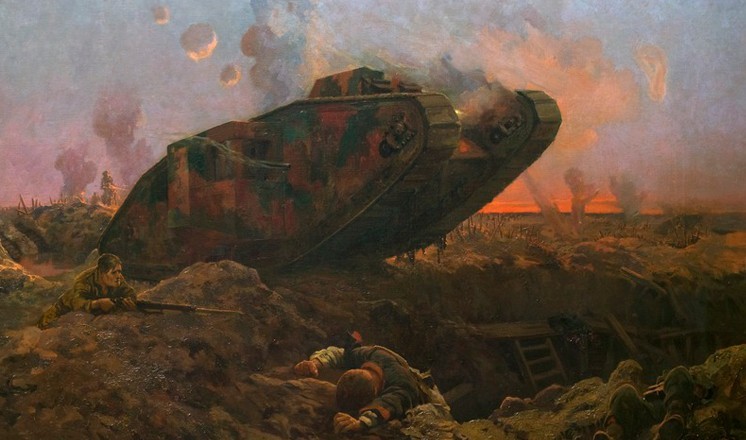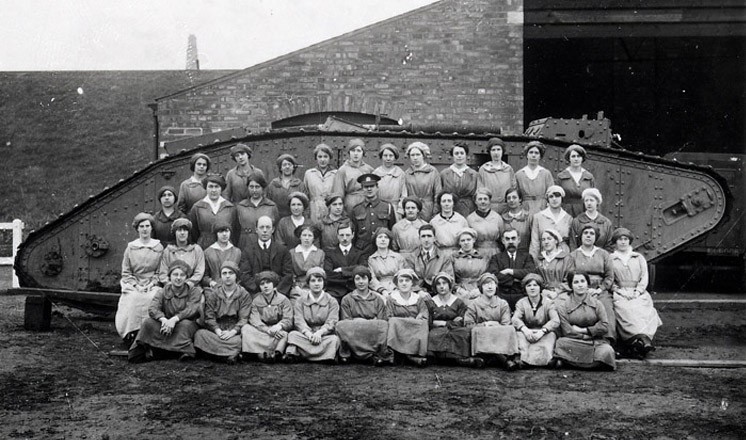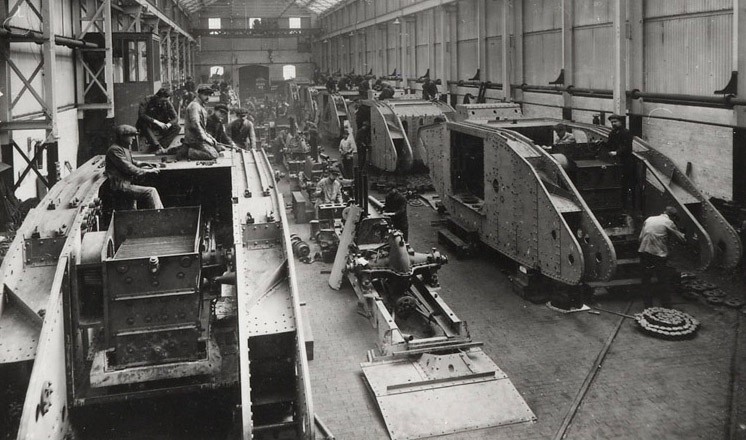A Tank in Action
RSS FeedA Tank in Action: marking the centenary of the tank
John's Hassall's famous painting of A Tank in Action is a vivid depiction of a tank rolling across the battlefield during the First World War. In the painting a battle has recently unfolded and its aftermath is laid out before the viewer.
The tank's centenary
1916 is the tank's centenary year. It was developed at William Foster & Co. Ltd, Lincoln, an agricultural engineering company. Foster's managing director, William Tritton, and chief draughtsman, William Rigby met with the War Cabinet's Major Wilson in a room in the White Hart Hotel, Lincoln to discuss plans for developing ‘a machine, strongly armoured, carrying powerful guns, capable of negotiating reasonable obstacles in the battle area and crossing the opposing trenches’. This brief had been laid down by the Admiralty Landship Committee in 1915, having a great need to tackle the problems of men and equipment becoming bogged down in the mud on the battlefield.
The first prototype was named Little Willie after William Tritton, but the caterpillar tracks kept coming off during testing in waste ground near to the factory, so on the second tank the tracks were built all around the body. This tank was known as Big Willie, later renamed Mother.
The tank was in full production in 1916 at Fosters, and as production increased and reliability improved they were used in greater numbers. Britain used Mark I tanks in combat for the first time in the Battle of Flers-Courcelette on 15 September 1916 (part of the Battle of the Somme) but they were limited in number and not used effectively. The Battle of Cambrai in November 1917 saw the first use of tanks on a large scale when an advance was made of 5 miles. Although this battle was not ultimately the greatest success, it was a precursor of the tactics the British would employ more successfully towards the end of the war.
Camouflage
It was recognised there was a need to camouflage the tanks, and Solomon J Solomon, RA, a portrait painter, who was a Lieutenant Colonel in the Royal Engineers, was employed to design the first camouflage colour scheme. He visited France to study the landscape of the battlefield and developed a scheme on scale models. Mother was the first tank to be painted in June 2016. Solomon provided his own paints and brushes but he didn't leave a description of his colour scheme. Basil Henriques, an officer of C Company, recalls him painting '… as if he were covering a canvas for the Royal Academy' and 'the effect was a kind of rather jolly landscape in green against a pink sunset sky'.
The first tanks painted with Solomon's colours were sent to France in August 2016 and were immediately repainted with browns and blacks. The scheme did not fit with the landscapes now visible at the Somme, very different from those seen by Solomon in the spring, then unbroken and green, where they were now a wasteland destroyed by artillery fire and mud.
The painting
John Hassall RA was commissioned by William Foster & Co. Ltd in 1917 to paint a tank, and it is believed Mother was the tank used as a model; there are differences in some of the details on Mother to the Mark I production tanks. Solomon's camouflage scheme is evident in the painting and it does seem to match Henriques' description. A second very similar painting by Hassall is in the collection of The Tank Museum, Bovington.
Further information
Further information on the development of the tank, and the tank in the collection at the Museum of Lincolnshire Life, may be found in an online exhibition on Lincs to the Past here.
An exhibition entitled The Great War Remembered, 1916 Conscription, Objection and the Rise of the Tank at the Museum of Lincolnshire Life runs from 10 September 2016 to 2 January 2017.
John Hassall's original oil painting A Tank in Action is currently on display at the Usher Gallery until January 2017. It can be seen alongside another of Hassall's paintings A Short Seaplane.
Comments
There aren’t any comments for this blog yet



